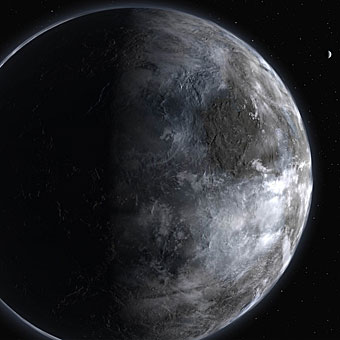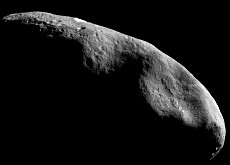Astronomers find Earth-like planet

Swiss and European astronomers say they have discovered the first planet outside our solar system able to support life.
But anyone thinking of a change of scene had better not hold their breath: the new “super-Earth” lies 20.5 light years or 120 trillion miles away.
The planet, whose mass is five times that of the Earth’s – hence the “super” tag – was discovered by a team of European astronomers led by researchers from Geneva University.
Its radius is 1.5 times that of the Earth and its gravity is twice that of our planet. Scientists estimate that its average temperature is between zero and 40 degrees Celsius, creating the possibility that water exists on the planet.
“We have all the ingredients for the development of life,” Stéphane Udry, an astronomer at the Geneva Observatory, told swissinfo.
“We have something that is solid or with water, that is about the same size as the Earth, the gravity is not too bad and it is just at the right distance from its star for the temperature to be around 20 degrees, so water could exist in liquid form.”
Outer space
The planet was discovered using the Swiss-designed High Accuracy Radial Velocity for Planetary Searcher (Harps) spectograph telescope, based at the European Southern Observatory at La Silla, Chile.
Its star, which is one-fiftieth as luminous as our Sun, is among the 100 closest to our solar system – and in the words of Udry, “very near to us”.
That might be true in the context of the universe but in reality it is a long, long way away. The chances of dispatching the equivalent of Nasa’s Mars Rover mission to find out more are as remote as the new planet.
“It’s just not possible because you would need centuries or even thousands of years to get there,” said Udry.
Habitable planets
But two planned space projects – one in Europe called Darwin and one in the United States called Terrestrial Planet Finder – are expected to find out more about habitable extrasolar planets or exoplanets, albeit at a distance.
“If you have light coming from a planet then you can start to analyse the chemical composition of the atmosphere of the planet,” said Udry. “Then you can see if there is water and even if there is life, because if there is oxygen in great amounts then there should be life making this oxygen.”
The Geneva astronomer said finding traces of life was important from both a philosophical and sociological point of view. He said the more we knew about how life developed in the universe, the better our understanding of the world would be.
“The further we go, the more we are convinced that it’s just a question of time and technology before we find life on other planets of the same sort as we have here. But it doesn’t mean intelligent life,” said Udry.
swissinfo, Adam Beaumont in Geneva
The new planet takes 13 days to orbit its sun.
Its mass is five times that of the Earth.
The radius of the planet is about 1.5 times the size of the Earth.
Its star’s luminosity is around one-fiftieth that of our sun.
The so-called “super-Earth” is the smallest of the 220 exoplanets discovered to date.
According to Michel Mayor of the Geneva Observatory, none of the previous discoveries offer the necessary conditions for life.
The research team included scientists from the Laboratory of Astrophysics in Grenoble, the Institute of Astrophysics in Paris and Lisbon’s Centre for Astronomy and Astrophysics.

In compliance with the JTI standards
More: SWI swissinfo.ch certified by the Journalism Trust Initiative










You can find an overview of ongoing debates with our journalists here . Please join us!
If you want to start a conversation about a topic raised in this article or want to report factual errors, email us at english@swissinfo.ch.